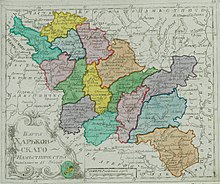Sloboda Ukraine
This article needs additional citations for verification. (September 2009) |
Sloboda Ukraine
| |
|---|---|
| |
 Location of Sloboda Ukraine (yellow) in Ukraine | |
| Country | Ukraine, Russia |
| Regions | East Ukraine, Central Black Earth Region |
| Cities | Sumy, Okhtyrka, Izyum, Ostrogozhsk |
| Capital | Kharkiv |
| Parts | Kharkiv Oblast, Luhansk Oblast, Sumy Oblast, Belgorod Oblast, Voronezh Oblast, Kursk Oblast, Donetsk Oblast |
Sloboda Ukraine (Ukrainian: Слобідська Україна, romanized: Slobidska Ukraina; Russian: Слободская Украина, romanized: Slobodskaya Ukraina), commonly known locally as Slobozhanshchyna (Ukrainian: Слобожанщина, IPA: [sloboˈʒɑnʃtʃɪnɐ]; Russian: Слобожанщина, romanized: Slobozhanshchina, IPA: [sləbɐˈʐanʲɕːɪnə]), is a historical region located in northeastern Ukraine and southwestern Russia. It developed and flourished in the 17th and 18th centuries on the southwestern frontier of the Tsardom of Russia. In 1765, it was converted into the Sloboda Ukraine Governorate.
Etymology
Its name derives from the term
Geographical extent
The territory of historic Sloboda Ukraine corresponds to the part of the present-day Ukrainian oblast (province) of Kharkiv (in its entirety), and parts of the Sumy, Donetsk, and Luhansk Oblasts, as well as parts of the Belgorod, Kursk, and Voronezh Oblasts of Russia.[10]
History

Russia gained control over the territory as a result of conquests against the Grand Duchy of Lithuania during the Muscovite–Lithuanian Wars in the 16th century.
According to Russian and Ukrainian sources of the 16th-17th centuries, the region was initially part of the Russian state,
The Cossacks who arrived in Sloboda, Ukraine were under the sovereignty of Russian tsars and their military chancellery, and were registered in Russian military service.[13] Many Ukrainian refugees arrived from Poland-Lithuania after the Ostryanyn uprising of 1637-1638 and received generous resettlement subsidies from the Russian government.[14] For decades, Ukrainian Cossacks crossed the border into southern Russia to gather livestock. Still, many of them engaged in banditry, prompting Russia to establish a new garrison town on the Boguchar River to defend the land from Ukrainian bandits.[15] Russia also resettled many of the Ukrainian refugees at Valuyki, Korocha, Voronezh, and as far as Kozlov.[16]

During those raids, regions near
Apart from the Cossacks, the settlers included
From 1650 to 1765, the territory referred to as Sloboda Ukraine became increasingly organized according to Cossack military custom, similar to that of the

The administration of
In 1835, the province of Sloboda Ukraine was abolished, ceding most of its territory to the new
After the establishment of the
During World War II, the region was occupied by Nazi Germany from 1941 to 1943.
During the Russian invasion of Ukraine, several battles were fought in the region, including battles fought in Kharkiv, Trostianets, Sumy, Okhtyrka, Lebedyn, Izium, and Bakhmut.
Largest cities and towns
References
- ^ Vasmer Etymological Dictionary
- ^ Orest Subtelny. Ukraine: A History. University of Toronto Press, 1988
- ISBN 0-8020-0830-5
- ^ From Kievan Rus' to modern Ukraine: Formation of the Ukrainian Nation (with Mykhailo Hrushevski and John Stephen Reshetar). Cambridge, Massachusetts: Ukrainian Studies Fund, Harvard University, 1984.
- ^ Грушевський М. Історія України-Руси. Том II. Розділ V. Стор. 4
- ^ Історія української літературної мови. Київ — 2001 (Перше видання Вінніпег — 1949)
- ^ Толочко П. П. «От Руси к Украине» («Від Русі до України») 1997
- ^ Енциклопедія українознавства. У 10-х томах. / Головний редактор Володимир Кубійович. — Париж; Нью-Йорк: Молоде життя, 1954—1989.
- ISBN 978-966-00-0197-8
- ^ a b c d e What Makes Kharkiv Ukrainian, The Ukrainian Week (23 November 2014)
- ^ Слюсарский А. Г. Социально-экономическое развитие Слобожанщины XVII— XVIII вв. Харьков. 1964. С. 11
- ^ Слюсарский А. Г. Социально-экономическое развитие Слобожанщины XVII— XVIII вв. Харьков. 1964. С. 29
- ^ a b Brian Davies. Empire and Military Revolution in Eastern Europe: Russia's Turkish Wars in the Eighteenth Century. Bloomsbury Publishing. 2011. P. 44
- ^ a b Brian Davies. Empire and Military Revolution in Eastern Europe: Russia's Turkish Wars in the Eighteenth Century. Bloomsbury Publishing. 2011. P. 45
- ^ Brian Davies. Warfare, State and Society on the Black Sea Steppe, 1500–1700. Routledge. 2007. P. 100
- ^ Brian Davies. Warfare, State and Society on the Black Sea Steppe, 1500–1700. Routledge. 2007. P. 101
- ^ Слюсарский А. Г. Социально-экономическое развитие Слобожанщины XVII— XVIII вв. Харьков. 1964. С. 30
- ^ Слюсарский А. Г. Социально-экономическое развитие Слобожанщины XVII— XVIII вв. Харьков. 1964. С. 32
- ^ Ісаєв Т. О. Цареборисів: від заснування до утворення Ізюмського слобідського полку // Вісник Харківського національного університету імені В. Н. Каразіна, 2010, No 906, С. 91
- ^ ISBN 9785446088706. St. Petersburg, 1901, First publication: 1865
- ^ a b Unknown Eastern Ukraine, The Ukrainian Week (14 March 2012)
External links
- Sloboda in the Encyclopedia of Ukraine
- The autonomous hetman state and Sloboda Ukraine in the Encyclopædia Britannica
Further reading




